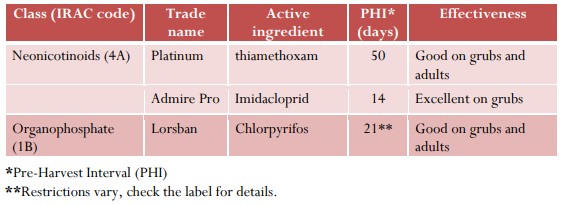Strawberry Root Weevil and Black Vine Weevil
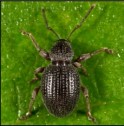
Strawberry root weevil (SRW; Fig 1) and black vine weevil (BVW; Fig 2) can be found in strawberry in Wisconsin. SRW adults are 1/5” long, shiny black to light brown with rows of small pits along their back, and a prominent blunt snout (Fig 1). BVW adults are larger than SRW, a little less than ½” long, dull black with yellow small flecks on the back (Fig 2).
Larvae of both weevils are quite similar: they are C-shaped cream-colored legless grubs with a brown head, about 12 mm long. BVW is native to Europe and was first introduced to the US in the early 1900s. In both species, the adults cannot fly; they walk or get carried on plant material or equipment from one location to another. Adults feed at night and remain in the soil or leaf litter at the base of the plant during the day and climb up to feed on leaves at night. BVW adults are polyphagous and feed on over 150 plants.
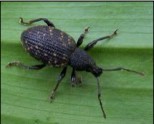
Another insect feeding on roots is the strawberry rootworm, which was discussed last summer in Wisconsin Fruit News Issue 10. Please, refer to that article for identification, damage symptoms, and management recommendations.
| Common Names | Strawberry root weevil and black vine weevil |
| Order | Coleoptera |
| Family | Curculionidae |
| Scientific Name | Otiorhynchus ovatus & Otiorhynchus sulcatus |
Life cycle
Adult females lay eggs in the soil where larvae develop, feeding on plant roots. BVW adults feed for 21-28 days on foliage prior to producing eggs. Interestingly, all adults are females that are capable of laying eggs through parthenogenesis (asexual reproduction). Females lay eggs in clusters of ~30 eggs in or on the soil from June to September. As soon as the eggs hatch after 10-14 days, larvae (Fig 3) wiggle down into the soil and start feeding on roots. Larvae will then overwinter in the soil. From April to June, larvae pupate, and adult begin to emerge. Adults move slowly and should not be confused with swifter predacious ground beetles. There is only one generation per year of each species.
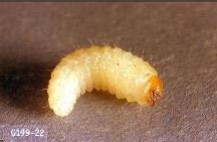
Damage
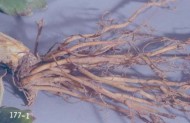
The main damage is caused primarily by the larvae feeding on the root system (Fig 4) in early spring. Damaged plants are weakened, stunted, more susceptible to winter injury and diseases, and may see a decrease in yield. Severe infestation may cause the plants to die. While adult weevils chew characteristic notches from the edges of leaves (Fig 5), their feeding is usually minor and does not result in economic loss.
Monitoring
Look at plantings in the spring for smaller, less vigorous plants and examine the roots for grub presence. In early summer, when adults begin to emerge, inspect leaves for leaf notching from adult feeding, especially on sucker growth near the ground. The presence of adults on top of foliage can be confirmed after dark on warm calm nights using a flashlight. You can also look for adults in plant debris at the base of the plant during the day. Laying a small piece of cardboard next to strawberry plants provides a refuge that can be checked easily in the early morning for the presence of adults. In the fall, you can look for areas with weak growth that redden prematurely. Although an old threshold, for BVW, between 2-8 larvae per strawberry plant (20x20cm soil sample including damaged plants) was determined to cause economic damage. If grubs are found in the spring, insecticides should be applied after harvest, when adult weevils emerge and start feeding but before egg laying occurs.
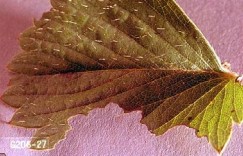
Biological control
Nematodes, such as Heterorhabditis spp. and Steinernema spp., may provide some control of weevil larvae when applied as a drench (following label directions) in the root zone where grubs are present.
Cultural Control
Cultivation of the soil in early spring before planting can eliminate overwintering larvae. Cereal cover crops can be planted in rotation, as small grains are not hosts for root weevils.
Chemical Control
If the use of an insecticide is warranted, for optimal control it is best to spray at night, between dusk and midnight, on warm, calm evenings when adult weevils are the most active feeding on foliage. For BVW, because adults require foliage feeding for 3-4 weeks before laying eggs, the first foliar application targeting adults should be made three weeks after detection of the first adult. Adults do not all emerge at the same time, thus a second foliar spray should be applied three weeks after the first one.
A list of available insecticides to control weevils in strawberry is provided in the following table. This is not an exhaustive list of insecticides. For other fruit crops, be sure to read the label to make sure they are registered for that specific crop in Wisconsin. There are many other tradenames available, and we do not recommend these that are listed above other options. All product recommendations can be found in the Midwest Fruit Pest Management Guide. Additionally, you should always fully read and follow the label before spraying any pesticide.
